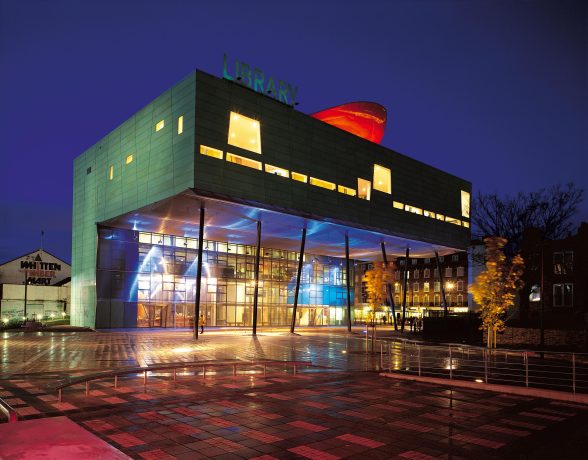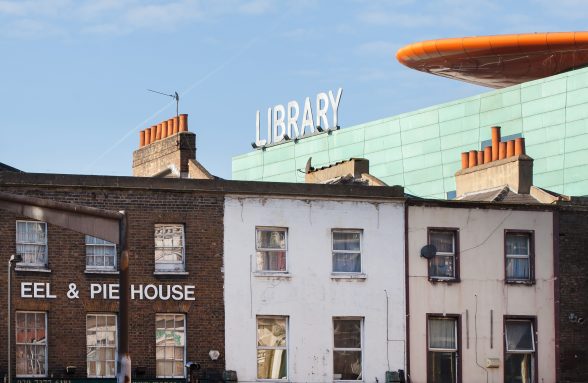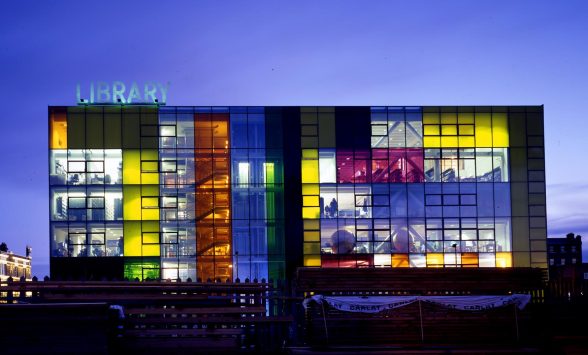This website uses cookies
This website uses cookies to enable it to function properly and to analyse how the website is used. Please click 'Close' to accept and continue using the website.



Image: Roderick Coyne / Alsop Arch
Following concerns regarding an application for intrusive new rooftop plant equipment, C20 has submitted a listing application for the celebrated Peckham Library in Southwark, South London, recommending it be considered for Grade II* status. Designed by Alsop and Störmer, the library opened in 2000 and won the Stirling Prize for Architecture in the same year. It is widely considered one of the most important works of the late Will Alsop, who passed away in 2018, and a landmark millennial project.
The application comes just a week after news that the architects’ Le Frégate Cafe in Jersey (1997) has been Grade II listed – making it the youngest listed building in the British Isles and the first Alsop project to be added to the national register.

Image: Kim Haddon, Flickr
Characterful roofscape
The Society has been alerted to a planning application for the installation of new air source heat pump equipment and acoustic enclosures on the south side of the roof, replacing existing extractor fans. While steps to upgrade and improve the energy efficiency of the building are to be welcomed, the Society believe the siting of this plant equipment would negatively impact on the significance of the library and key views of the roof.
The library has a highly characterful roofscape which is most striking when experienced from longer ranging viewpoints. The roofscape is a key contributor to the overall design of the building with its welcoming ‘LIBRARY’ sign and distinctive vermillion ‘beret’ above the central reading room pod, with domes flanking it to either side.
From higher vantage points, the air source heat pumps and associated enclosures would be visible and disruptive to the otherwise cohesive roofscape, competing and obscuring its artistic features. An alternative location for the new equipment should be found, which would have a less harmful impact on the building’s overall heritage significance.

Image: Alsop Arch
‘A container for a new approach to education’
The pre-patinated copper clad library cleverly inverts traditional spatial arrangements, creating an outdoor public space within its plot at ground floor, by suspending a large proportion of the library space 12 metres up on spindly steel stilts. Asked why this unconventional approach was taken, Alsop dryly replied “Why not?”.
In fact, the overhang of the library shelters part of the square from the weather and creates a semi-secret world above, elevated from the Peckham’s lively and bustling streets. A feeling reinforced by the timber pods within the main library space, containing a children’s activity area, meeting room and specialist Afro-Carribean library. The rear facing elevation on New Theatre Walk is a multi-coloured glass curtain wall, glowing like a beacon during the hours of darkness and affording spectacular long range views of the city skyline.
This boundary blurring design adds to its openness, making Peckham Library an approachable yet aspirational community building; ‘A container for a new approach to education and information’ [Ken Powell]

Image: Alsop Arch
Millenial Projects
Following the creation of the National Lottery in 1994, the Millennium Commission was established by the Major government, to identify worthy projects to allocate lottery funding to. Of the buildings they funded, many were designed by the foremost ‘starchitects’ of the day and have become a shorthand for early 21st century Britain; from the Tate Modern to the Eden Project, the Angel of the North to the Millenium Dome. But beyond those instant national icons, regional city centres and towns across the country also benefited from new arts venues, public buildings, civic infrastructure and sculptures, in a building boom unprecedented since the immediate postwar period. It is in this context, that Peckham Library is considered one of the notable and successful ‘Millenial projects’. Indeed, membership of the library is significantly higher than the borough average for all age groups, and particularly so for teenagers, with a membership per-capita twice the Southwark average.
With many of these buildings soon to be reaching the thirty year age threshold – one of the key criteria for national listing – C20 is increasingly focussed on researching and reviewing this period, to identify the most outstanding contributions to the built environment, as the twentieth century made way for the twenty first.

Image: Roderick Coyne / Alsop Arch
C20 Director Catherine Croft commented:
‘Peckham Library radically redefined what a library was. Putting accessibility and nurturing a community at the heart of its mission, with innovative and playful architecture that makes it a distinctive, much loved
landmark.
Recently listed La Frégate is Alsop at his most frivolous, and while Peckham may look similarly light-hearted, it’s an intensely serious building with bold social ambition, deliberately turning its back on the past.
When Alsop collected the Stirling Prize (the UK’s most prestigious architecture award) for this building in 2000, he reputedly mothed “Fuck the past!” at the TV cameras. Now this provocation of history is history itself.’

Image: John East

Become a C20 member today and help save our modern design heritage.